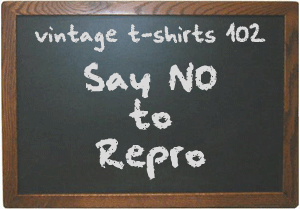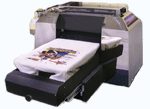Vintage Tees 102: Give Bootlegs the Boot
Other guides:
Vintage T-Shirts 101: eBay Shopping Guide.
Vintage T-Shirts 103: The Brand Gallery.
Vintage T-Shirts 104: Identify Fakes.

Note: This guide was authored in 2007, 14 years later the landscape of fakes and forgeries has changed dramatically. Counterfeiters are now using far more advanced techniques including manufacturing fake tags and convincingly pulling off all-over prints. We recently compiled a modern vintage t-shirt authentication guide.
The guide below offers the basics and especially the importance of comparing prints with a known original. Sign up for our mailing list for the latest authentication techniques.
This page contains a form, you can see it here
Making sure your item is genuine is tricky sometimes since listings can be misleading. The recent surge of counterfeit vintage shirts online breaks our hearts. Some of these operations sell very convincing fakes (we’re actually amazed) mixed amongst genuine pieces. Others print new designs on plain vintage shirts. Many of these dealers buy repros in bulk – so you’ll notice multiple sellers carrying many of the exact same prints. With all these creative and sneaky techniques, it’s become even trickier to get the real deal.
But we know the auction format can be tempting so just be aware there are certain red flags to watch out for. Often, the listings will not display the tag – it will be removed, or look like an uncommon, yet vintage-esque brand. It’s gotten so out-of-hand that designs originally printed on only one color of shirt are starting to appear in an array of other colors. If Bill and Ted were to chime in now, you can bet they’d say, “Bogus!”
If the written details and photos in the listing are scarce and non-descriptive, do your research. Keep in mind some listings misuse “vintage” as a keyword to generate exposure for other items. Look for sharp close-ups of a copyright date. Consider the actual look of the printing, as many reproductions use just one color. Also, inspect the quality of the printing – watch for inaccurately sized, wrongly placed, poorly colored, or pixelized prints.

What does this analogy tell us about identifying fakes? First off, most counterfeiters don’t have the original image to work with, so they scan a copy of it. The integrity of the design is compromised because colors and fine lines aren’t matched properly. Sometimes entire colors or details are omitted if it’s too difficult to pick up or used very little in the original design.

Given these indications of forgery, the example above shows a comparison between an authentic design and a forgery, with close-ups of their subscripts. Notice the differences in color, detail and copyrights. When compared side by side, it’s obvious which is which. On their own, though, it’s less apparent which is the repro. Make sure to do comparative shopping.
